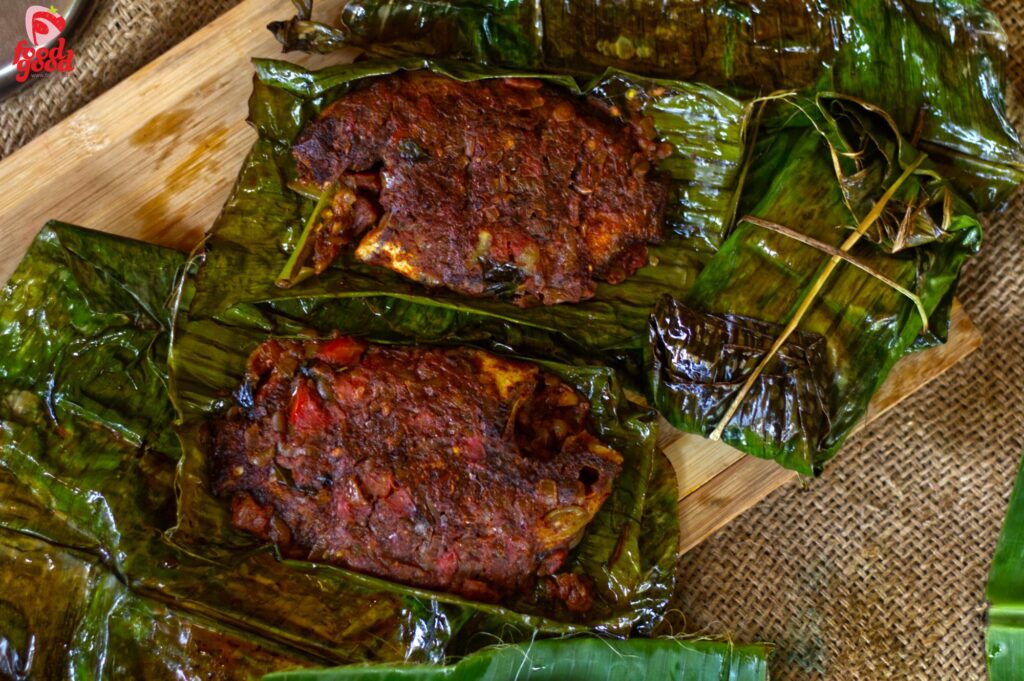There’s a kind of silence that falls at the table when Karimeen Pollichathu is served – not out of formality, but out of pure anticipation. The moment that banana leaf is unwrapped, and the warm, spiced aroma escapes into the air, everyone knows: this isn’t an everyday dish.
I remember first tasting Karimeen Pollichathu on a houseboat drifting through the backwaters of Alleppey. The setting couldn’t have been more perfect – coconut trees leaning into the water, the slow rhythm of paddles somewhere in the distance, and on the plate, a fish that felt like it had soaked in every flavour of Kerala.
Karimeen, or pearl spot, is a freshwater fish native to Kerala’s rivers and lagoons, especially in the Kuttanad and Kumarakom region. It’s small, round, and bony – but it makes up for it in taste. The texture is delicate, and the flavour mild yet distinctive, like it was made for masala. No wonder it’s so revered in our cuisine. In fact, it’s considered the official fish of Kerala.
The method of Pollichathu – wrapping food in banana leaf and cooking it – has been part of traditional kitchens for generations. It’s not just a technique; it’s a way of sealing in everything. First, the fish is marinated, usually in a mix of red chili, turmeric, black pepper, and lemon. Then it’s lightly fried, just to seal the surface. The real magic happens next – a thick masala is cooked down with onions, garlic, ginger, and curry leaves, rich with the scent of coconut oil and sometimes a touch of coconut milk. The fish is slathered in this and wrapped tightly in banana leaf.
And then, it waits – on a pan, on low flame, slowly cooking in its own steam, the leaf lending its earthy aroma while the masala settles into every corner of the fish. When it’s finally opened – soft, hot, and glistening – it’s impossible not to pause.
Karimeen Pollichathu might have once been a dish reserved for special guests or festive tables in Christian households, but now, it belongs to every part of Kerala. From houseboats and heritage resorts to toddy shops and home kitchens, it’s become something of a statement – of care, of pride, of knowing how to take something simple and make it extraordinary.
Even now, far from the backwaters, I try to recreate it on weekends. Of course, finding pearl spot isn’t easy everywhere, and banana leaves aren’t always within reach. But the moment I smell that masala – the ghee, the curry leaves, the spice – I’m right back at that table by the water, unwrapping a memory.
Kerala Karimeen Pollichathu
Ingredients
Instructions
-
Clean the fish thoroughly and keep it aside.
-
Mix half teaspoon turmeric powder, three teaspoons chili powder, two teaspoons black pepper powder, and enough salt.
-
Add one and a half tablespoons lemon juice to the mixture and make a smooth paste. Add water if needed.
-
Make shallow cuts on both sides of the fish and apply the marinade paste evenly over it.
-
Heat oil in a pan and fry the fish until 70% cooked. Set aside.
-
In the same oil, add half a cup of sliced shallots. Add more oil if needed.
-
Sauté the shallots for a while, then add 1–2 green chilies and a sprig of curry leaves. Continue sautéing.
-
When the shallots are soft, add two sliced tomatoes and cook well.
-
Once the tomatoes are cooked, add one teaspoon ginger-garlic paste and enough salt.
-
Add 1/4 teaspoon turmeric powder, 1 teaspoon chili powder, 1/2 teaspoon black pepper powder, and 1/2 teaspoon coriander powder. Mix everything well and sauté.
-
When the mixture becomes dry, add coconut milk and cook until it becomes soft and thick like a paste.
-
Prepare the banana leaf by lightly heating it over an open flame. This will make the leaf flexible and easier to fold.
-
Place one banana leaf on a flat surface. For added protection, place another banana leaf over it.
-
Spread some cooked masala on the leaf, place the fried fish on it, and cover the fish with more masala on both sides.
-
Fold the banana leaf into a tight bundle around the fish and tie it with thread to secure.
-
Heat some oil in a pan, place the banana leaf bundle in it, and pour a little more oil on top. Cover with a lid and cook.
-
After a few minutes, flip the bundle and cook the other side until both sides are lightly browned.
-
Remove from heat. Karimeen Pollichathu is ready to serve. Enjoy it with traditional Kerala meals.


